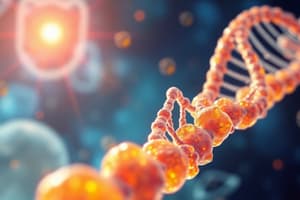Podcast
Questions and Answers
What is the function of DNA replication?
What is the function of DNA replication?
DNA replication copies the DNA and its genes each time a cell divides so newly formed cells have the correct gene material.
Why is DNA replication considered 'semi-conservative'?
Why is DNA replication considered 'semi-conservative'?
One original and one new strand composes the DNA making it semi-conservative.
What does DNA helicase do?
What does DNA helicase do?
DNA helicase unwinds and unzips the DNA double helix.
What is the direction of the lead strand in DNA replication?
What is the direction of the lead strand in DNA replication?
What is the direction of the lagging strand in DNA replication?
What is the direction of the lagging strand in DNA replication?
What role does DNA polymerase play on the lead strand during replication?
What role does DNA polymerase play on the lead strand during replication?
What is the importance of complementary base pairing in DNA replication?
What is the importance of complementary base pairing in DNA replication?
Describe the process of DNA replication on the lagging strand.
Describe the process of DNA replication on the lagging strand.
Why does DNA replication occur in a 5' to 3' direction?
Why does DNA replication occur in a 5' to 3' direction?
Summarize the roles of the key enzymes involved in DNA replication.
Summarize the roles of the key enzymes involved in DNA replication.
Flashcards are hidden until you start studying
Study Notes
DNA Replication Overview
- DNA replication is essential for copying DNA and genes during cell division, ensuring new cells receive correct genetic material.
- The process is termed "semi-conservative" since each new DNA double helix contains one original strand and one newly synthesized strand.
Key Enzymes and Their Functions
- DNA Helicase: Responsible for unwinding and unzipping the DNA double helix, enabling access for replication.
- DNA Polymerase III: Links nucleotides to form a new DNA strand, adds nucleotides in the 5' to 3' direction, using a template strand.
- RNA Primase: Synthesizes short RNA primers to initiate DNA synthesis on both strands.
- DNA Polymerase I: Replaces RNA primers with DNA nucleotides on the 5' end of newly formed strands.
- DNA Ligase: Joins together Okazaki fragments on the lagging strand, ensuring a continuous DNA strand.
- DNA Gyrase: Alleviates strain and supercoiling tension as DNA unwinds during replication.
Specific Strands in DNA Replication
- Leading Strand: Synthesized continuously in the 5' to 3' direction.
- Lagging Strand: Synthesized in short segments called Okazaki fragments in the 3' to 5' direction, requiring multiple RNA primers.
Importance of Complementary Base Pairing
- Ensures the conservation of the base sequence during replication, producing identical DNA copies.
- Errors in base pairing can lead to mutations, impacting gene expression and cell function.
Process of Lagging Strand Replication
- Helicase unwinds DNA for accessibility.
- Primase synthesizes RNA primers for initiating replication.
- DNA Polymerase III synthesizes new DNA strands in 5' to 3' direction from the primer.
- DNA Polymerase I replaces primers with DNA.
- DNA ligase stitches together discontinuous fragments (Okazaki fragments) for a complete DNA strand.
Directionality of DNA Replication
- DNA strands are anti-parallel; replication occurs exclusively in the 5' to 3' direction.
- Polymerase III only adds nucleotides to the growing strand in this 5' to 3' orientation, aligning with the strand's direction.
Summary of Enzyme Roles
- DNA helicase: Unwinds double helix.
- DNA polymerase III: Adds nucleotides to expanding DNA strand.
- RNA primase: Creates starting points for replication.
- DNA polymerase I: Fills in gaps left by RNA primers.
- DNA ligase: Seals nicks in the sugar-phosphate backbone.
- DNA gyrase: Reduces supercoiling during unwinding.
Studying That Suits You
Use AI to generate personalized quizzes and flashcards to suit your learning preferences.




